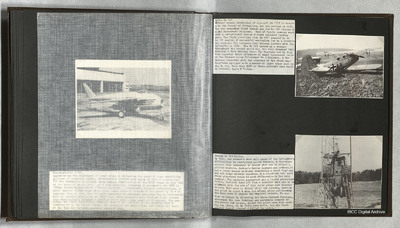Gotha Go 145 and Bachem Ba 349
Title
Gotha Go 145 and Bachem Ba 349
Description
Photo 1 is the Go 145 biplane seen from the rear/starboard on the ground.
Photo 2 is the Ba 349, a vertically launched rocket powered fighter. It is seen here on its launch frame.
Photo 2 is the Ba 349, a vertically launched rocket powered fighter. It is seen here on its launch frame.
Coverage
Language
Type
Format
Two b/w photographs on an album page
Publisher
Rights
This content is available under a CC BY-NC 4.0 International license (Creative Commons Attribution-NonCommercial 4.0). It has been published ‘as is’ and may contain inaccuracies or culturally inappropriate references that do not necessarily reflect the official policy or position of the University of Lincoln or the International Bomber Command Centre. For more information, visit https://creativecommons.org/licenses/by-nc/4.0/ and https://ibccdigitalarchive.lincoln.ac.uk/omeka/legal.
Identifier
PThomasAF20080018
Transcription
Gotha Go 145.
Gothaer ceased production of aircraft in 1919 in accordance with the Treaty of Versailles, but was revived in 1933. The new companies [sic] first design was the Go 145 trainer a night harassment bi-plane. Made of fabric covered wood with a conventional design & fixed tailskid landing gear. The first prototype flew in 1933 powered by an As 10C engine, & successful evaluation led to a production contract for trainers that entered service with the Luftwaffe in 1934. The Go 145 served as a trainer throughout the second world war, but from December 1942 acquired a more martial role. The Russians had by this time launched their offensive of night harassment raids on the Germans using Polikarpov Po 2 biplanes, & the Germans responded with the creation of the Stork ampfstaffeln equipped with a number of light types such as the Go 145. More than 9500 of these aircraft were built in Germany, Spain & Turkey.
[Photograph]
Bachem Ba 349 Natter.
By 1944, the german’s [sic] were well aware of the Luftwaffe’s difficulties in countering Allied bombers, & therefore ordered four companies to design what was in effect a piloted missile. Bachem’s Natter (Adder) was ordered. It had a crude wooden airframe comprising a short fuselage mid set wings without ailerons, & a cruciform tail unit whose elevators could be used differentially for roll control. The in-built powerplant was a liquid propellant rocket. Vertical take off from a launcher unit was to be achieved with the aid of four solid propellant booster rockets that were to detach after ten seconds, leaving the pilot to climb & make his attack after jettisoning the nose cone to expose the unguided rockets. He was then to escape by detaching the whole forward fuselage, whereupon the rear fuselage was parachute lowered to the ground for re-use, whilst the pilot came down under his own chute. 15 Ba 349’s were built, but the first piloted launch crashed & killed the pilot.
[Photograph]
Gothaer ceased production of aircraft in 1919 in accordance with the Treaty of Versailles, but was revived in 1933. The new companies [sic] first design was the Go 145 trainer a night harassment bi-plane. Made of fabric covered wood with a conventional design & fixed tailskid landing gear. The first prototype flew in 1933 powered by an As 10C engine, & successful evaluation led to a production contract for trainers that entered service with the Luftwaffe in 1934. The Go 145 served as a trainer throughout the second world war, but from December 1942 acquired a more martial role. The Russians had by this time launched their offensive of night harassment raids on the Germans using Polikarpov Po 2 biplanes, & the Germans responded with the creation of the Stork ampfstaffeln equipped with a number of light types such as the Go 145. More than 9500 of these aircraft were built in Germany, Spain & Turkey.
[Photograph]
Bachem Ba 349 Natter.
By 1944, the german’s [sic] were well aware of the Luftwaffe’s difficulties in countering Allied bombers, & therefore ordered four companies to design what was in effect a piloted missile. Bachem’s Natter (Adder) was ordered. It had a crude wooden airframe comprising a short fuselage mid set wings without ailerons, & a cruciform tail unit whose elevators could be used differentially for roll control. The in-built powerplant was a liquid propellant rocket. Vertical take off from a launcher unit was to be achieved with the aid of four solid propellant booster rockets that were to detach after ten seconds, leaving the pilot to climb & make his attack after jettisoning the nose cone to expose the unguided rockets. He was then to escape by detaching the whole forward fuselage, whereupon the rear fuselage was parachute lowered to the ground for re-use, whilst the pilot came down under his own chute. 15 Ba 349’s were built, but the first piloted launch crashed & killed the pilot.
[Photograph]
Collection
Citation
“Gotha Go 145 and Bachem Ba 349,” IBCC Digital Archive, accessed November 5, 2024, https://ibccdigitalarchive.lincoln.ac.uk/omeka/collections/document/23283.
Item Relations
This item has no relations.

